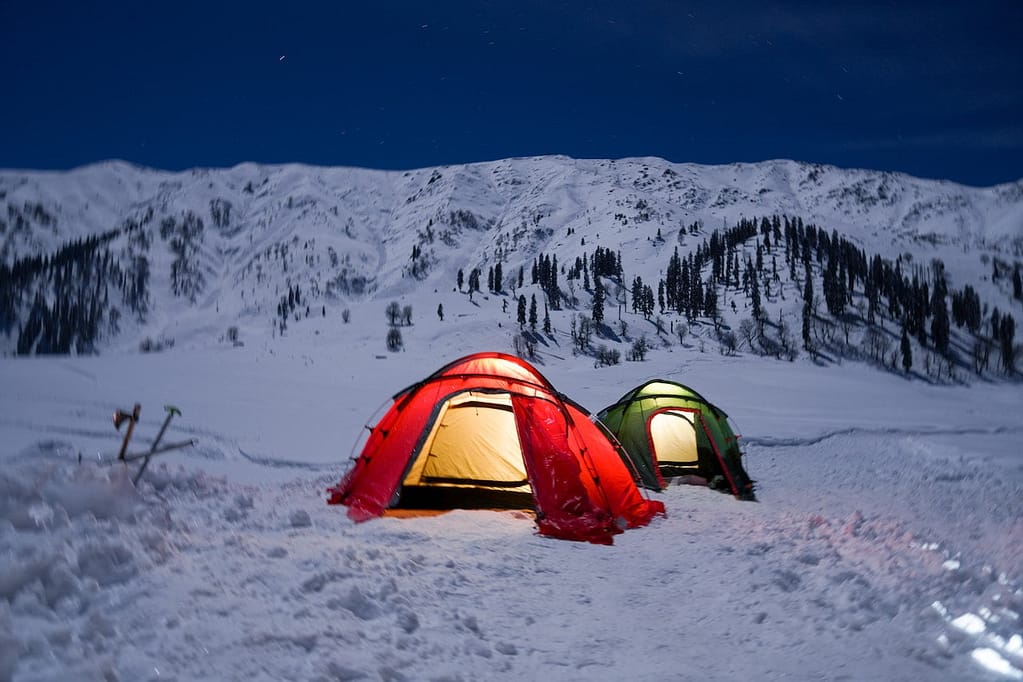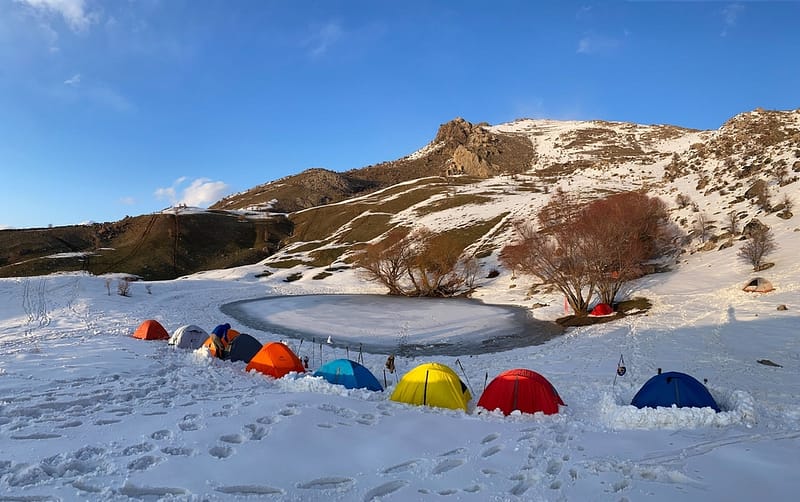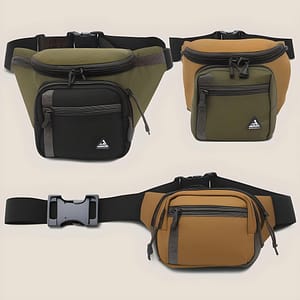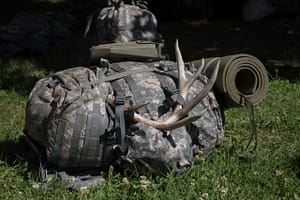In general Winter is a time when most of us prefer not to spend time camping. Winter raises difficulties in heating, insulation and in some countries and us states, where the rainy season is winter, also rain and mud. But if you still decided to go camping in the winter, an experience that I can say is truly unique, here is a guide to winter camping gear.
What type of tent is best for winter camping?

As winter rolls around and the temperatures drop, it’s time to gear up for some winter camping adventures. And let me tell you, choosing the right tent can make all the difference when it comes to staying cozy and comfortable in the great outdoors. So I present to you the best tent for winter camping :
Now, you might be wondering what makes a four-season tent so special. Well, let me break it down for you. These bad boys are specifically designed to withstand the harsh winter conditions, keeping you warm, dry, and protected from the elements. They are made from durable materials that can handle heavy snow, strong winds, and frigid temperatures. And of course it is desirable that they be water resistant. Trust me, when the weather is throwing a tantrum, you’ll be glad you have a four-season tent by your side.
But hold on, before you go rushing to buy just any four-season tent, let’s talk about some key features to look out for. First and foremost, you want a tent with a sturdy frame and solid poles. Remember, you’re dealing with heavy snow here, so you need something that can hold its own against the weight. Look for tents with aluminum poles, which are lightweight yet strong.
Next up, insulation is your best friend in the winter wonderland. Look for a tent with good ventilation and a rainfly that covers the entire tent. This will help keep the warm air in and the cold air out.
Find Out How to Insulate a Tent.
What type of sleeping bag should I use in cold weather?

So we talked about the right tent, but before you strap on your snowshoes and head out into the frozen wilderness, there’s one important question you need to answer: What type of sleeping bag should you use in cold weather? I think I have all the answers you need to stay cozy and warm.
When it comes to choosing a sleeping bag for cold weather, there are a few key factors to consider. First and foremost, you’ll want to make sure your sleeping bag is up to the task of keeping you snug as a bug in a rug. Look for a bag with a temperature rating that suits the conditions you’ll be camping in. If you’re expecting sub-zero temperatures, opt for a bag with a lower temperature rating to ensure you won’t wake up feeling like an icicle.
Next up, insulation is the name of the game. Down or synthetic? That is the question. Down sleeping bags are known for their exceptional warmth-to-weight ratio and incredible compressibility, making them a favorite among seasoned winter campers. However, they can be a bit pricier and lose their insulation properties if they get wet. On the other hand, synthetic sleeping bags are more budget-friendly and retain their warmth even when wet. Just keep in mind that it might not be as compressible as down, which means it might take up a bit more space.
What type of sleeping pad should I use in cold weather?
When it comes to sleeping pads, you want something that provides both comfort and insulation. After all, a night spent shivering on the cold ground is nobody’s idea of a good time.
For winter camping, I recommend going for a sleeping pad with a high R-value. R-value? What’s that, you ask? Well, it’s a fancy way of measuring how well a sleeping pad can resist heat flow. The higher the R-value, the better the insulation. So, in the world of sleeping pads, a high R-value is your winter camping best friend.
Now, let’s talk about material. You have a few options here: foam, air, or self-inflating. Foam sleeping pads are the old-school choice, and they do a great job at insulating you from the cold ground. They may not offer the same cushy comfort as air or self-inflating pads, but they are lightweight and durable.
Air sleeping pads, on the other hand, provide excellent cushioning and are a dream to sleep on. They’re like floating on a cloud, but without the worry of drifting away. Just make sure to choose one with a built-in pump, so you don’t have to blow it up with your icy breath.
Self-inflating pads are the happy medium between foam and air. These magical pads have a layer of open-cell foam inside that automatically expands and draws in air when you open the valve. It’s like your own personal air mattress that sets itself up.
The best thing about self-inflating pads is that they provide both comfort and insulation. The foam inside acts as a cushion, giving you a cozy surface to sleep on. And let’s face it, after a long day of hiking through the snow, you deserve a good night’s sleep. But it doesn’t stop there. These pads also have a high R-value, which means they’re great at keeping the cold ground at bay.
One thing to keep in mind when choosing a self-inflating pad is the thickness. You want to make sure you have enough padding to keep you comfortable throughout the night. I mean, who wants to wake up feeling like they slept on a rock? Look for a pad that’s around 2 to 3 inches thick for optimal comfort.
What type of clothing should I wear for winter camping?
One of the most important aspect of your winter camping gear: Clothing.
When it comes to dressing for winter camping, the key is to layer up like a warm and cozy onion. You want to make sure you have enough layers to keep you warm, but also the option to shed some if you start to feel like a human furnace. Here’s a breakdown of the essential clothing items you’ll want to pack for your wintery adventure:
1. Base Layers:
Start with a good set of moisture-wicking base layers. These will help keep you dry and comfortable by wicking away sweat from your body. Go for a snug fit, but not too tight, as you’ll want some room for air circulation. Look for materials like merino wool or synthetic blends.
2. Mid Layers:
Next, add some insulation with mid layers. These can be fleece or down jackets, sweaters, or even a cozy flannel shirt. The key here is to trap air to create an insulating layer. Feel free to mix and match different mid layers depending on the temperatures you’ll be facing.
3. Outer Layers:
To protect yourself from the elements, you’ll need a good outer layer. Here are some recommendations for outer layers that will make you feel like a winter camping superhero:
A. The Blizzard-Beater Jacket: This jacket is like a fortress against the cold. It’s made with advanced insulation technology that will keep you toasty even in the harshest winter conditions. The Blizzard-Beater is also waterproof, so you won’t have to worry about getting soaked if it starts snowing or raining. Plus, it has plenty of pockets to store all your essentials, like snacks and hand warmers.
B. The Ice Warrior Pants: These pants are built to withstand the coldest of temperatures. With a durable outer shell and thick insulation, they will keep your legs warm and protected. The Ice Warrior Pants are also water-resistant, so you can confidently trek through snow or slush without getting wet. And let’s not forget about the handy zippered pockets, perfect for storing your phone or a small flask of hot cocoa.
C. The Frostbite-Proof Gloves: Your hands are precious, so you need gloves that will keep them cozy and frostbite-free. The Frostbite-Proof Gloves are made with a combination of insulation and waterproof materials, ensuring maximum warmth and dryness.
What type of stove is best for winter camping?

It’s time to talk about the unsung hero of winter camping gear – the stove. First things first, when it comes to winter camping, you need a stove that can withstand the freezing temperatures and still perform like a champ. You don’t want to be left shivering and hungry. let’s explore the main 2 types of the camping stove world:
1. The Liquid Fuel Legend:
For those who prefer versatility and reliability, the liquid fuel stove is your go-to winter camping sidekick. These babies can run on various fuels like white gas, kerosene, diesel, and even unleaded gasoline. They might require some tinkering and priming in freezing temperatures, but once they’re up and running, they’ll keep your meals sizzling hot. Plus, you’ll feel like a true survivalist, knowing you can scavenge for fuel in the direst of situations.
2. The Propane Powerhouse:
Imagine this: you’re nestled in your cozy tent, the snowflakes gently falling outside, and you’re craving a steaming cup of hot cocoa. Enter the propane stove, the dependable companion of winter warriors. These bad boys are compact, easy to use, and can blast out some serious heat. Just hook up the canister, ignite the burner, and voila! You’ve got yourself a mini kitchen right there in the wilderness.
Propane stoves are perfect for winter camping because they offer a consistent and adjustable flame, allowing you to fine-tune your cooking temperature. Plus, they’re incredibly efficient, so you won’t have to worry about running out of fuel in the middle of a snowstorm. Just make sure to bring enough propane canisters to keep the fire burning.
What type of snowshoes should I use for winter camping?

One of your trusty companions for winter camping is the snowshoes. With so many types out there, you’ll need the right pair of paws to navigate those pristine snowscapes.
1. The “Yeti’s Bigfoot” Snowshoes:
For those who want to leave a monstrous impression in the snow, the “Yeti’s Bigfoot” snowshoes are your ticket to fame! With enormous surface area and gargantuan footprints, you’ll practically be leaving behind billboards in the snow for other campers to admire. Just don’t get too confident and try moonwalking with these bad boys, or you’ll end up face-first in a snowbank.
2. The “Ninja Stealth” Snowshoes:
If you’re planning a covert winter mission, the “Ninja Stealth” snowshoes are your go-to choice. Sleek, lightweight, and almost as silent as the winter wind, you’ll move through the snowy terrain like a ninja stalking its prey. Just imagine the look of surprise on your friends’ faces when they turn around and find you right behind them, thanks to your stealthy moves.
3. The “Fashionista Flurry” Snowshoes:
Who says winter camping can’t be stylish? For those who prioritize fashion over function, the “Fashionista Flurry” snowshoes are the way to go. With vibrant colors, fancy patterns, and maybe even a bit of faux fur, you’ll be the trendsetter of the winter wonderland.
Is it necessary to bring a fire starter when winter camping?
My answer is a resounding YES – bringing a fire starter is an absolute must for winter camping. First things first, if you’re camping in frigid temperatures, a roaring fire is crucial for staying warm. It’s your ultimate savior, providing both heat and a morale-boosting ambiance. Plus, who doesn’t love roasting marshmallows and sharing ghost stories around a cozy fire? Imagine this next scenario, The “Yeti in a Sleeping Bag” Scenario:
you’re huddled in your tent, cocooned in your sleeping bag, trembling like a leaf, and your hands feel as nimble as a bear’s paws in mittens. Now, let’s add the challenge of rubbing two icy sticks together to create fire. I’m sorry it’s not happening, unless you possess the magical powers of a fire-bending wizard, a reliable fire starter is your lifeline to warmth and survival. Trust me; you won’t find any mystical yetis handing out fire-making tutorials.
Now, let’s talk about the different types of fire starters available:
1. The “Matches of Destiny”:
Ah, matches. The classic fire starter that has been around for centuries. They’re like the Gandalf of fire starters, standing tall and steadfast against the forces of darkness (or in this case, the forces of cold). Just make sure you bring along a waterproof container to store them in, unless you want your matches to turn into soggy noodles.
2. The “Flick of the Wrist”:
If you’re feeling a bit fancy and want to impress your camping buddies, the flint and steel fire starter is the way to go. With a swift flick of your wrist, you’ll create sparks that will make even Mother Nature jealous. Just be prepared for the occasional “oh, let me try” from your friends, followed by a series of failed attempts and laughter.
3. The “Fire Fairy”:
For those who like a little magic in their lives, the fire starter cubes are like tiny fire fairies just waiting to make your camping dreams come true. All you need to do is light one up, and voila! Instant fire. It’s like having your own personal fire-breathing dragon, minus the scales and the need for dragon food.
Conclusion: what are the winter camping essentials?
1. Yeti-Worthy Sleeping Bag: Snuggle up in a sleeping bag that could rival the warmth of a Yeti’s den. Look for one with a cozy temperature rating, like a furnace for your toes, to keep you toasty even when the cold tries to sneak in.
2. Thermos of Liquid Sunshine: A trusty thermos filled with hot cocoa, coffee, or tea is like a sip of liquid sunshine on a chilly morning. It’ll be your morale booster and secret weapon against Jack Frost’s icy antics.
3. Toasty Thermal Layers: Layer up like a pro with thermal long johns and moisture-wicking clothing. It’s like having a personal team of snow bodyguards to protect you from the cold.
4. Winter Warrior Tent: Your shelter should be sturdy enough to brave winter’s wrath. A four-season tent with a robust rainfly will be your fortress against snowstorms and gusty winds.
5. Snow Ninja Boots: Your feet need to be happy campers too! Invest in insulated, waterproof boots with a tread that could rival a snow leopard’s grip.
6. Firestarter Magic Wand: Summon the warmth of a crackling campfire with a reliable firestarter. Be it flint, waterproof matches, or a trusty lighter, this magic wand is a winter camper’s best friend.
7. S’more Supplies Galore: Winter camping without s’mores? Unthinkable! Pack marshmallows, chocolate, and graham crackers to elevate your camping treats to legendary status.
8. Navigation Wizardry: Winter landscapes can be deceiving, so a map, compass, or GPS will be your trusty navigation wizards, ensuring you don’t end up like a frosty gnome lost in the woods.
9. Beanie and Mittens Brigade: Keep your head and hands in the cozy brigade with a warm beanie and insulated mittens. They’ll fend off the chill like a superhero duo.
10. First-Aid Enchantment Kit: Just in case winter’s magic gets a little mischievous, carry a well-stocked first-aid kit to handle bumps, bruises, and other winter surprises.





